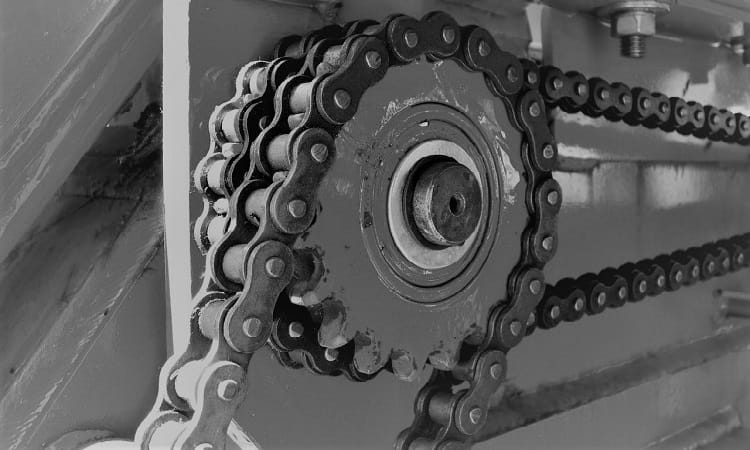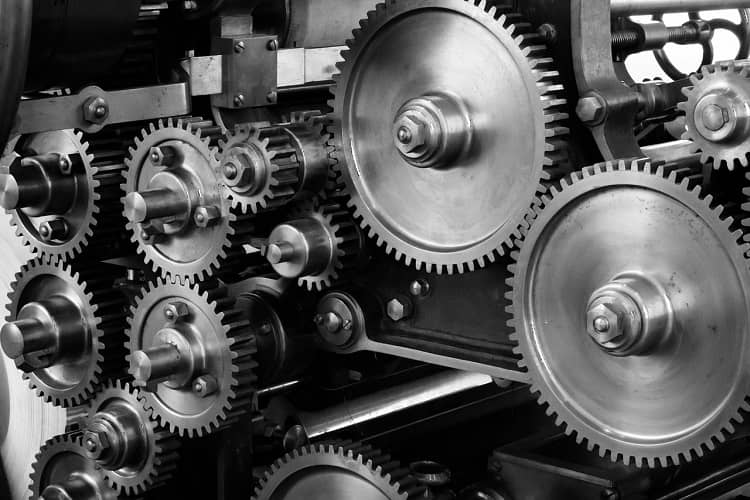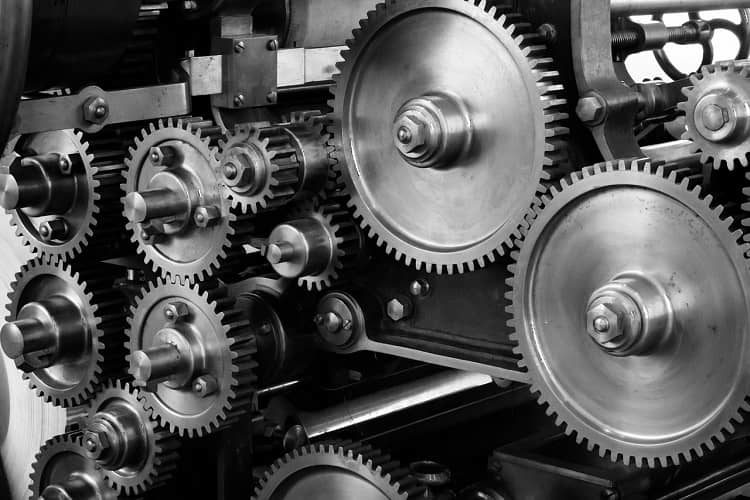Machine can be defined as a cluster of mechanisms that can perform certain tasks in a pre-defined way by expending energy. Most functions of a machine are carried out by utilizing mechanical power, which is supplied by prime movers. A prime mover can convert one form of energy to mechanical energy (in the form of rotational torque). First and foremost example can be electric motor, where electrical energy is converted into mechanical energy. Similarly, steam turbine, hydraulic turbine, wind mills, etc. also act as prime mover in certain cases, especially for heavy duty applications. Such prime movers are usually located away from the machine units and thus requires another means to transmit power to machines.
Mechanical power transmission system serves this purpose. It retrieves motion, torque and power from prime movers and subsequently transfers to the intended locations of the machine units. Apart from transmission, it can also change direction of rotation and alter speed to fulfil exact requirement in machines. Mechanical power transmission system consists of four basic drives, namely gear drive, chain drive, belt drive and rope drive. For easy and uninterrupted power transmission, it also takes help of other mechanical elements such as brake, clutch, shaft, spline, key, coupling, etc. Each of the four mechanical drives offer certain benefits over others and thus is suitable for specific applications.

Contrary to the friction drive (belt drive and rope drive), both chain drive and gear drive are engagement type mechanical drive as power is transmitted by means of successive engagement and disengagement. In chain drive, an endless chain passes through sprockets of driver and driven shafts, which in turn introduces flexibility into the system. It can be employed for short to medium distance power transmission. Although it is free from slip, polygonal effect limits this drive from offering constant velocity ratio. Gear drive, on the other hand, is one rigid drive due to the absence of any intermediate flexible element. It is suitable for small distance power transmission and acts as a positive drive. Various differences between chain drive and gear drive are given below in table format.
Table: Difference between chain drive and gear drive
| Chain Drive | Gear Drive |
|---|---|
| In chain drive, an intermediate element (chain) connects the sprockets of driver and driven shafts. | No such intermediate element exist in gear drive. Gears of the driver and driven shafts mesh directly. |
| It is one flexible drive because of the presence of flexible chain. | It is one rigid drive as no flexible link exist. |
| It can damp vibrations and protect the drive unit from failure. | It cannot protect the system from vibration. |
| Chain drive is suitable for transmitting power and motion over short to medium centre distance. | Gear drive is preferred for short distance power and motion transmission. |
| Chain drive cannot be used for non-parallel shafts. | Certain gear drives (like bevel and worm) are meant for non-parallel shafts only. |
| With chain drive, the driver and driven shafts rotate in same direction. | With gear drive, the driver and driven shafts rotate in opposite direction. |
| Chain drive is not true positive drive. Although it is free from slip, but velocity ratio may vary due to polygonal effect. | Gear drive offers positive drive and velocity ratio remains constant. |
| Chain drive is not suitable for very high speed reduction. | Gear drive can be advantageously used for small to high speed reduction. |
| Although it requires regular lubrication, chain drive does not require full lubrication. | Gear drive requires full lubrication for smooth operation and prolonged service life. |
Presence of intermediate element and flexibility: Mechanical drives can be classified based on presence or absence of intermediate linkage. A flexible drive is one where a flexible intermediate linkage between the driver and driven shafts exists. Belt drive, chain drive and rope drive are examples of flexible drive due to presence of belt, chain and rope, respectively as intermediate linkage between two shafts. Such linkage introduces flexibility in the drive unit and thus they can be utilized for long distance power transmission. On the other hand, when no such intermediate linkage exist then that mechanical drive is termed as rigid drive. Gear drive is an example of rigid drive as two rigid gears come in direct contact via their teeth. No intermediate element is required in between two gears as they mate directly.
Vibration damping: One advantage of every flexible drive is its capability to damp vibrations. Usually driver unit such as prime mover produces limited and tolerable vibrations; however, machine unit may undesirably produce excessive vibration. Impact or shock loading, unbalanced force, loose joints, dynamic parts and broken or damaged component are prime sources of vibration in machine unit. Such high-amplitude vibration, if transmits to the prime mover, can cause severe damage. In every flexible drive, the intermediate flexible element can damp vibration inherently. Due to absence of any intermediate linkage in rigid drive, vibration in machine unit is transmitted to the prime mover. Thus a chain drive can isolate the driver unit but a gear drive cannot protect it from excessive undesirable vibration.

Preferred distance of power transmission: Basic objective of every mechanical drive is to transmit motion and power from driver shaft to driven shaft. Distance between driver and driven shafts may vary based on several factors such as shop-floor lay out, availability of space, safety issues, etc. Each mechanical drive is suitable for a range of shaft distance. Chain drive can be employed for small to medium centre distance, typically between 1 – 5m in a single stage. It can also be employed for higher shaft distance by utilizing additional idle supports. On the other hand, gear drive is preferable for small centre distance, typically below 1m; otherwise bulk size gears are required to employ, which will consume space and increase system weight. By utilizing idle intermediate gears, power can also be transmitted over longer distance; however, that will increase system weight and power loss and thus efficiency will decrease.
Power transmission between non-parallel shafts: Driver and driven shafts may have various orientations. They may be (i) parallel, (ii) intersecting, or (iii) non-parallel but non-intersecting. A suitable mechanical drive is selected based on this relative orientation. All three flexible drives (belt, chain and rope) are suitable for parallel shafts only. Although, quarter-turn belt can be employed for perpendicular shafts, it is rarely used in practice due to many limitations. Chain drive can transmit power between parallel shafts only. On the other hand, gear drive can be employed for any orientation of the driver and driven shafts. There exist various types of gears—each one is suitable for a particular orientation. For example, spur gear and helical gear are preferred for parallel shafts, bevel gear is preferred for intersecting shafts, and worm gear is suitable for perpendicular but non-intersecting shafts.
Direction of rotation: Another requirement of mechanical drive is to alter the direction of rotation as per the requirement. In machines, required rotational direction may be either same or opposite with that of prime mover. A single stage chain drive can rotate the driven shaft in same direction as the driver shaft. If multiple shafts are required to rotate, then chain drive can provide rotation in both directions. On the other hand, a single stage gear can rotate the driven shaft only in opposite direction to the driver shaft. To get rotation in same direction, intermediate gear is required to use.
Positive drive: A mechanical drive that can provide constant velocity ratio during its operation is called positive drive. Such constant speed is required to maintain in many applications; for example, thread cutting in lathe, automatic screwing, etc. None of the friction drive can provide constant velocity ratio due to inherent slip. Although chain drive is free from slip, but polygonal effect can alter velocity ratio marginally. Thus it is not considered as positive drive. Gear drive is the only example of positive drive.
Achievable speed reduction: Usually the prime mover rotates at much higher speed than it is intended in machine unit. This requires stepping down of rotational speed, which can be done by every mechanical drive. However, each drive has a limit in reduction capacity. A chain drive can provide speed reduction in between 1:1 to 1:5, in a single stage. On the other hand, gear drive can provide a wide range of speed reduction, typically between 1:1 to 1:100. Spur gear and bevel gear are preferred for small reduction, helical gear can provide medium reduction, and worm gear can provide steep speed reduction.
Lubrication: Being an engagement drive, two solid bodies come in direct contact, so heat generation and wear are common problem in both chain and gear drive. Use of suitable lubricating oil can mitigate such undesired effects. Chain drive requires frequent lubrication; while, most gear drives require full lubrication where gear unit is partially or completely immersed into lubricating oil.
Scientific comparison among chain drive and gear drive is presented in this article. The author also suggests you to go through the following references for better understanding of the topic.
- Design of Machine Elements by V. B. Bhandari (Fourth edition; McGraw Hill Education).
- Machine Design by R. L. Norton (Fifth edition; Pearson Education).
- A Textbook of Machine Design by R. S. Khurmi and J. K. Gupta (S. Chand; 2014).


